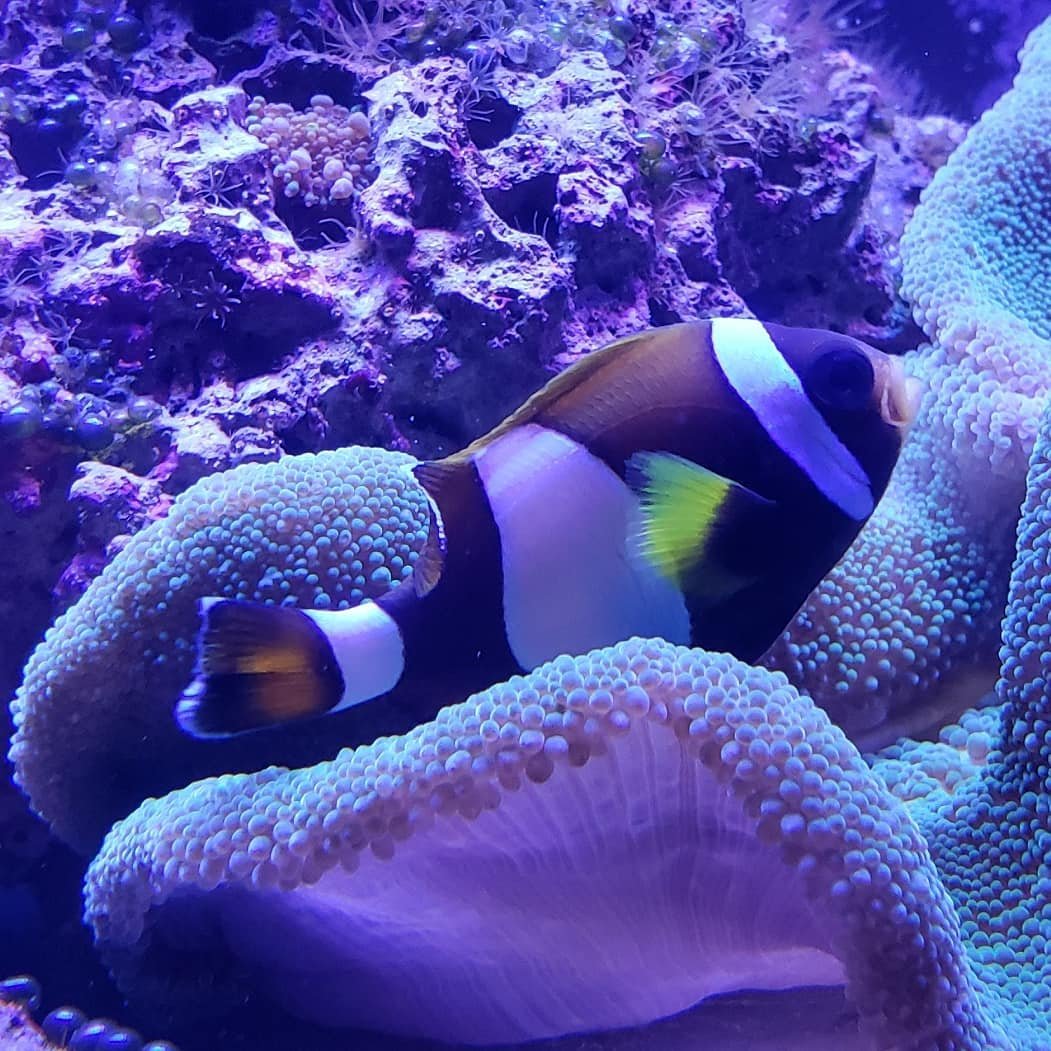Zawilec szerokopasmowy
Wide Band Anemonefish, Tiny: up to 1.5″ = $250.00
Wide Band Anemonefish, Small: over 1.5-2″ = $300.00
Wide Band Anemonefish, Medium: over 2-3″ = $350.00
Wide Band Anemonefish, Large: over 3-4.5″ = $400.00
Wide Band Anemonefish, X-Large: over 4-5″ = $500.00
Wide Band Anemonefish, NA, Australia, Pair = $600.00
Scientific Name: Amphiprion latezonatus
Kompatybilny z rafą: Tak
Poziom opieki: średni
Usposobienie: Półagresywne
Minimalny rozmiar zbiornika: 50 galonów
Mature Size: 5.5 inches
Dieta: wszystkożerna
Zasięg: wyhodowany w niewoli, hodowany w czołgu
$250.00
Description
Wide Band Anemonefish – Amphiprion latezonatus
Wide Band Anemonefish, the Wideband anemonefish differs from its other clownfish relatives in the fact that it has a large white band in the center of its body that broadens with age. It also has two other smaller white bars on its dark brown to black body. The caudal fin has a pale posterior margin. Wide Band Anemonefish Amphiprion latezonatus Clownfish,In Lord Howe Island Wide-Band Anemonefish, are more likely to evolve into new species.
The Latezonatus Clownfish, sometimes referred to as the Wide-Band or Lord Howe Clownfish, is found on the Eastern Australian Coast and Lord Howe Island. They are dark black in appearance with three white bands covering the body, with the middle band being far wider than the other two. The tail is also edged in white. These clownfish are infrequently available and make a wonderful addition to the fish only or reef aquarium.
A 50-gallon or larger aquarium is desirable. It may be kept in small groups and will be happier if a host anemone is present such as Haddon’s Sea Anemone (Stichodactyla haddoni). It becomes more aggressive towards conspecifics as it ages. The Latezonatus Clownfish diet consists of meaty foods such as mysis and enriched brine shrimp, herbivore preparations, and a high quality marine fish pellet and flake food.
Amphiprion latezonatus
Clownfish have long been among the most popular fishes in the marine aquarium trade. Due to advances in technology, along with a better understanding of the process, the supply of cultured clownfish has grown exponentially in the past 10 years. Several commercial farms grow thousands of these fish for the U.S. market every year. Now, a very rarely seen species (either wild or cultured) is at Quality Marine! We are excited to announce the arrival of aquacultured Wideband Clowns (A. latezonatus), after not having them available in any way for over two
Rozmiar: They reach a maximum length of six inches (15 cm).
Behavior: The Wideband anemonefish, like other anemonefish, has a symbiotic relationship with certain anemones (they both benefit). Both are protected from predators and exchange nutrients. The anemone provides protection, shelter and supplies food for the clownfish. In return, the clownfish defends the anemone from predators and parasites and provides nitrogen, which aids the anemone’s tissue growth. The clownfish is able to live among the anemone’s stinging tentacles due the protective, slimy mucus that coats the body. The social group of this anemonefish, within its host anemone, is one of hierarchy. There is one large dominant, sexually active female, one smaller sexually active male and a few smaller juveniles. When the dominate female leaves or dies, the largest male will change sex (sequential hermaphrodite) and become the dominant female and then the next largest male will become the sexually active one.
Diet: The diet of this anemonefish consists of copepods, algae, isopods and zooplankton.
Communication: Before breeding, to attract the female, the male communicates his intentions through chasing, biting at the substrate and extending his fins.
Reproduction: A nest is prepared on a flat, bare surface, such as rock, near the host anemone in order for the eggs to receive protection from predators. The female lays her sticky eggs in the nest where the male fertilizes and aerates them. The male guards and protects the eggs until they hatch. Habitat/range: They live on offshore reefs among anemones in cooler, temperate waters from southern Queensland to northern New South Wales and Lord Howe Island.
saddleback anemonefish, yellowfin anemonefish, maroon anemonefish, wild clownfish, hermaphrodite anemonefish, female maroon clownfish, clownfish colonies, clownfish anemone




Reviews
There are no reviews yet.